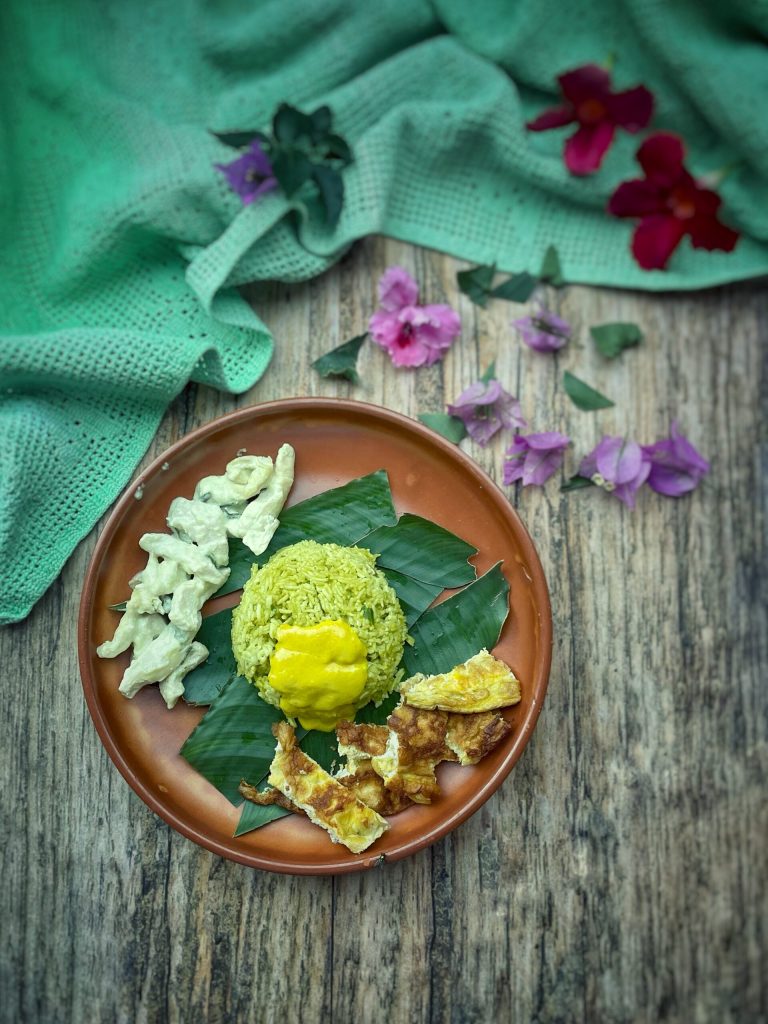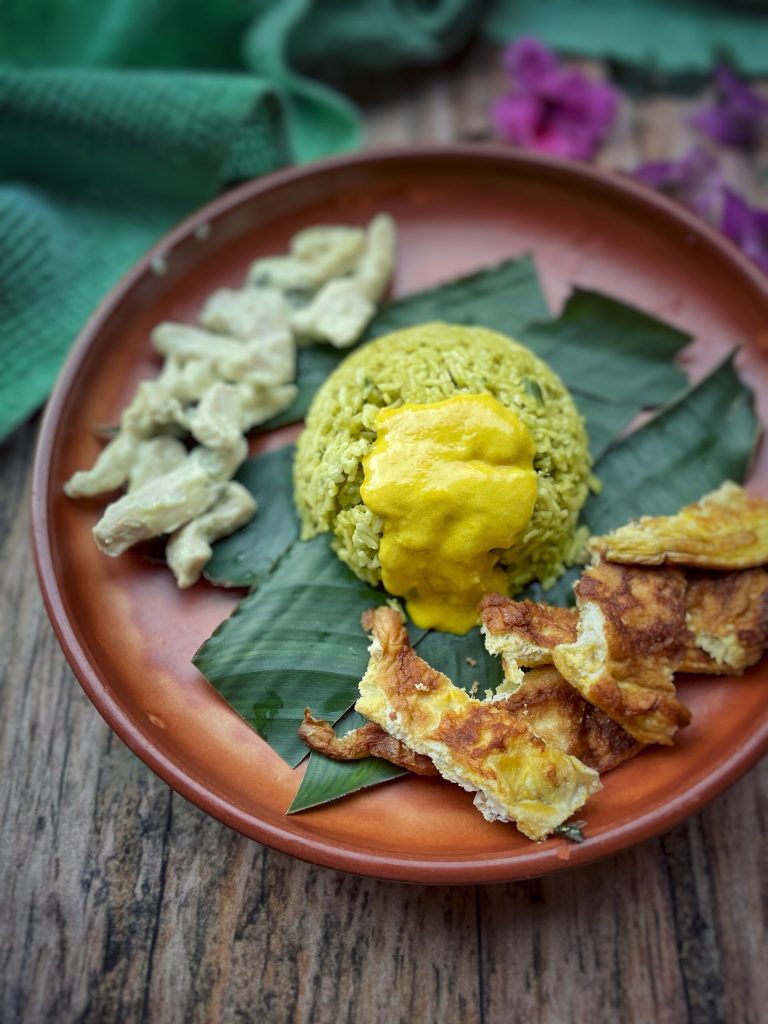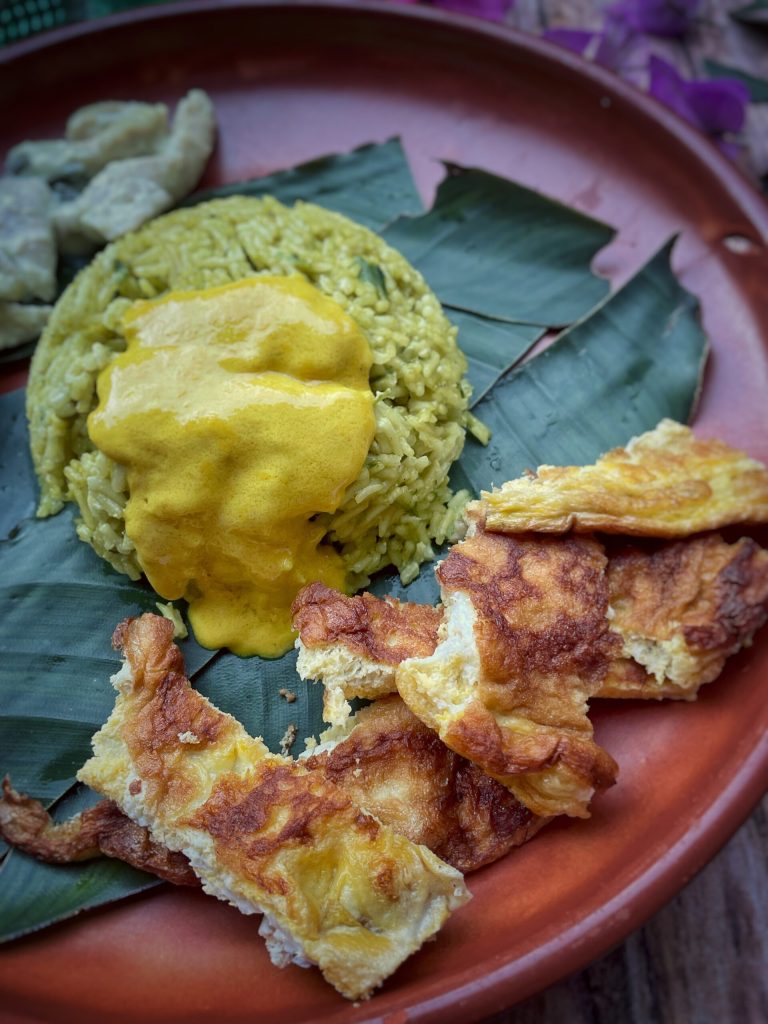The Nasi Liwet is a traditional Indonesian dish originating from Solo, in the Central Java region.
It involves rice cooked in coconut milk with aromatic spices, often served with various sides such as chicken, eggs, tempeh, coconut cream, and sambal.
It is often garnished with small slices of omelette (Telur Dadar Iris), Ayam Suwir, which is shredded chicken cooked in coconut milk, and a spoonful of a dense aromatic coconut cream called kumut.
Nasi Liwet has ancient roots and was traditionally served during royal ceremonies in the Javanese kingdom.
The term “liwet” refers to the method of cooking rice in coconut milk with aromatic spices.
Today, it is a popular dish throughout Indonesia, symbolizing abundance and conviviality, often prepared during celebrations and family gatherings.
There are various regional variants, including the Sundanese version from West Java, which features some differences in ingredients and preparation.

- Difficulty: Easy
- Cost: Economical
- Preparation time: 10 Minutes
- Portions: 4 People
- Cooking methods: Stovetop
- Cuisine: Indonesian
- Seasonality: All seasons
Ingredients
- 4 cloves garlic
- 0.35 oz fresh ginger
- 1 tbsp ground galangal
- 3 shallots
- to taste turmeric
- to taste cumin
- to taste coriander
- to taste pepper
- 10.5 oz long grain rice
- 1.1 cups coconut milk
- 1.1 cups water
- to taste ground cinnamon
- 2 cardamom pods
- 2 leaves kaffir lime
- 1 stalk lemongrass (crushed)
- 2 leaves pandan (tied)
- to taste salt
Steps
Prepare the spice paste: Blend all ingredients until you get a smooth paste.
Cook the rice: In a pot, mix the rice with the coconut milk, water, salt, pandan leaves, kaffir lime leaves, cinnamon stick, cardamom pods, and lemongrass. Add the spice paste and mix well. Bring to a boil, then reduce the heat and simmer for about 15 minutes, stirring occasionally, until the rice is tender and the liquid is absorbed.
Serve: Arrange the rice on banana leaves or a plate and accompany with traditional sides (see below)
Telur Dadar Iris
Eggs: 2
Salt: a pinch
Coconut oil: for greasing
Procedure: Beat the eggs with the salt, cook in a non-stick pan greased with a little oil, forming a very thin omelette. Roll and slice thinly into strips.
Ayam Suwir (shredded coconut chicken)
Chicken thighs or breast: 10.5 oz
Coconut milk: 0.85 cups
Garlic: 2 cloves, minced
Shallot: 1, minced
Salam leaves or bay leaves: 2
Salt: to taste
Procedure: Cook the chicken with all the ingredients over low heat until it shreds easily and the liquid reduces. Then shred it.
Kumut (spiced coconut cream)
Thick coconut milk (first press): 0.85 cups
Salam leaf or bay leaf: 1
Kaffir lime leaf: 1
Shallot: 1, finely chopped
Grated fresh turmeric: ½ tsp (or powder)
Salt: to taste
Procedure: Cook over low heat until the cream thickens and becomes aromatic, stirring often. It should be creamy and enveloping, almost like a sauce.
FAQ (Questions and Answers)
What is the Sundanese variant of Nasi Liwet?
The Sundanese version of Nasi Liwet, also known as Ngaliwet, features some differences.
Additional ingredients: it often includes petai (stinky beans), dried anchovies (ikan teri), and fermented soybeans.
Cooking method: The rice is cooked with these ingredients, often in a terracotta pot or a rice cooker, to achieve a crispy crust at the bottom.
Presentation: Traditionally served on banana leaves, with diners eating together using their hands, in a style known as liwetani.

